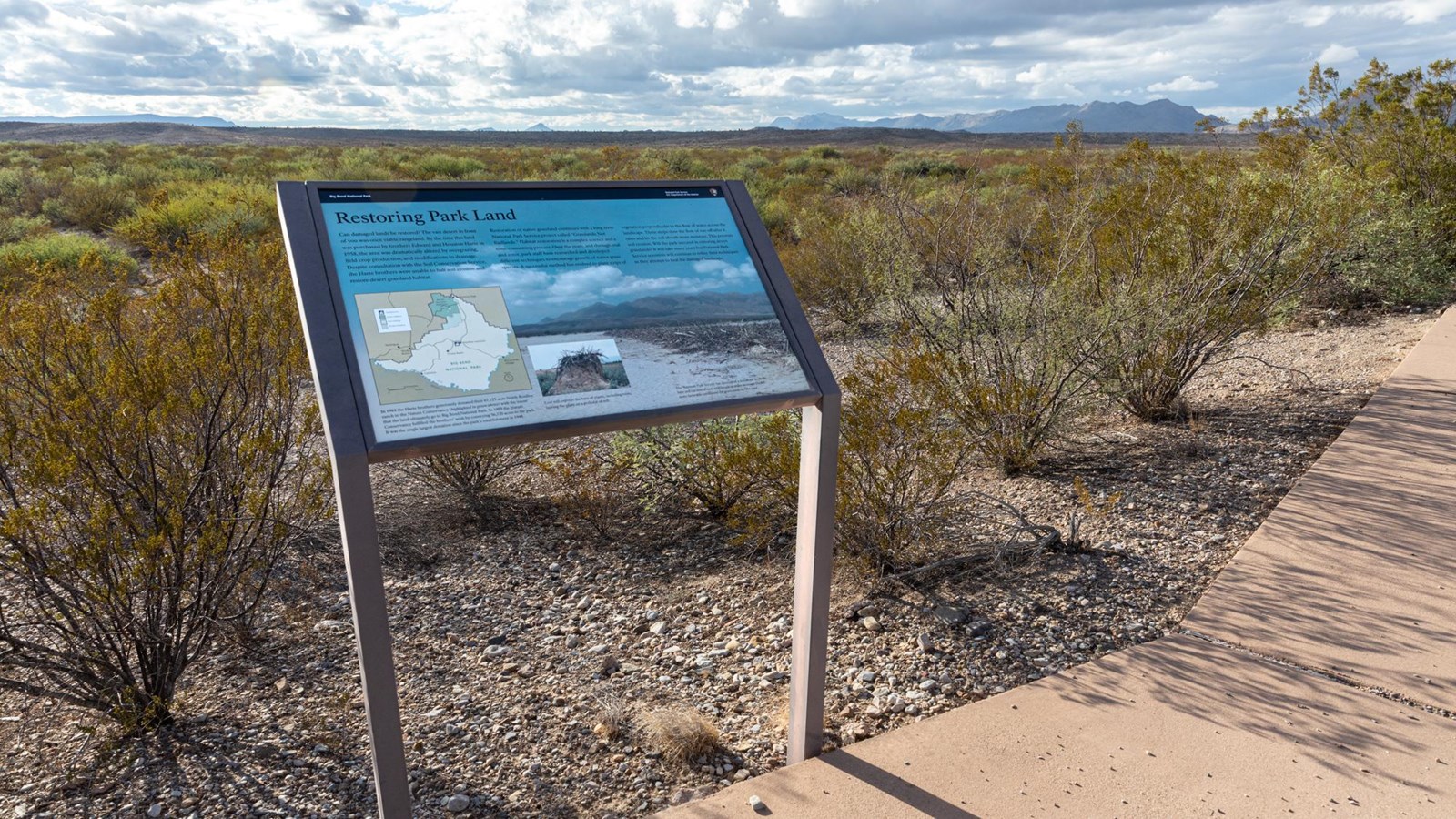Last updated: June 29, 2025
Place
Restoring Park Land Exhibit

NPS/CA Hoyt
Quick Facts
Location:
6.5 miles south of Persimmon Gap Entrance
Amenities
4 listed
Cellular Signal, Information Kiosk/Bulletin Board, Parking - Auto, Wheelchair Accessible
Can damaged lands be restored? The vast desert in front of you was once rangeland. Prior to the 1920s, reports describe this country as a grassland covered by tobosa grass. Setters say pronghorn once ran here over the grassy flats.
The text on the exhibit reads, "Can damaged lands be restored? The vast desert in front of you was once viable rangeland. By the time this land was purchased by brothers Edward and Houston Harte in 1958, the area was dramatically altered by overgrazing, field crop production, and modifications to drainage. Despite consultation with the Soil Conservation Service, the Harte brothers were unable to halt soil erosion and restore desert grassland habitat. Restoration of native grassland continues with a long-term National Park Service project called "Grasslands Not Badlands". Habitat restoration is a complex science and a time-consuming process. Over the years, and through trial and error, park staff have researched and developed different techniques to encourage growth of native grass species. A successful method has evolved to plant strips of vegetation perpendicular to the flow of water across the landscape. These strips slow the flow of run off after it rains and let the soil absorb more moisture. This prevents soil erosion. Will the park succeed in restoring desert grasslands? It will take many years but National Park Service scientists will continue to refine their techniques as the attempt to heal the damaged landscape."
A caption at the bottom of the sign reads, "In 1984 the Harte brothers generously donated their 67,125-acre North Rosillos ranch to the Nature Conservancy with the intent that the land ultimately go to Big Bend National Park. In 1989 the Nature Conservancy fulfilled the brothers' wish by conveying 56,720 acres to the park. It was the single largest donation since the park's establishment in 1944."
The text on the exhibit reads, "Can damaged lands be restored? The vast desert in front of you was once viable rangeland. By the time this land was purchased by brothers Edward and Houston Harte in 1958, the area was dramatically altered by overgrazing, field crop production, and modifications to drainage. Despite consultation with the Soil Conservation Service, the Harte brothers were unable to halt soil erosion and restore desert grassland habitat. Restoration of native grassland continues with a long-term National Park Service project called "Grasslands Not Badlands". Habitat restoration is a complex science and a time-consuming process. Over the years, and through trial and error, park staff have researched and developed different techniques to encourage growth of native grass species. A successful method has evolved to plant strips of vegetation perpendicular to the flow of water across the landscape. These strips slow the flow of run off after it rains and let the soil absorb more moisture. This prevents soil erosion. Will the park succeed in restoring desert grasslands? It will take many years but National Park Service scientists will continue to refine their techniques as the attempt to heal the damaged landscape."
A caption at the bottom of the sign reads, "In 1984 the Harte brothers generously donated their 67,125-acre North Rosillos ranch to the Nature Conservancy with the intent that the land ultimately go to Big Bend National Park. In 1989 the Nature Conservancy fulfilled the brothers' wish by conveying 56,720 acres to the park. It was the single largest donation since the park's establishment in 1944."
